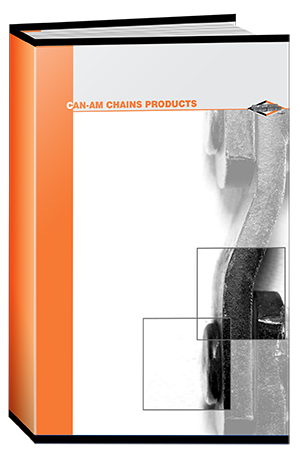Conveyor Chain Selection

-
Minimize the number of different chain sizes in use
This will assist in maintaining a smaller less costly inventory of replacement chain, rivets and links. For instance: Log handling from the outside storage deck to the live deck inside the sawmill. Storage deck - WR132 mill chain. Endo log haul to the debarker and away from the debarker - WR132. Use as a single strand conveyor with log cradle attachment; or a triple strand conveyor. Result - one chain and one sprocket size. The same example could be used in other applications on the mill floor. The refuse conveyors are particularly easy to standardize on chain size. Pick a standard drag chain such as WD110 or WD112. If one single strand will not carry the load, add wings for additional width; or run two strands side by side; or run two strands side by side with wings. The main refuse conveyor is in a place by itself because of heavy shock loads imposed upon it. Round or square link chain with flights or one of the CAN-AM Work Hog series chains is recommended. See "Super Hog"® or "Whole Hog"® specifications in the heavy duty drag chain section of the catalog. Call a CAN-AM representative, or the factory nearest you, for more details.
-
Chain speed
The lumber manufacturing plants of today are running conveyor chains at speeds unheard of until recently because of the small logs coming from the woods. This means that more care must be taken in the selection of chain and sprocket diameters. Large diameter sprockets are ideal when chains are to be run fast. If the sprocket cannot be a large diameter, a shorter pitch chain should be considered. For example: It has been decided to use WR132 for a chain speed of 250 - 300 FPM, using a 13 tooth sprocket. For some reason, the design of the structure will not allow the diameter of a 13 tooth sprocket. The sprocket space allowed in the WR132 is for a 9 tooth (17.69" P.D.), the WR124XHD 13 tooth has a pitch P.D. of 16.98". What has been said is the WR124XHD chain will run that speed better than the WR132 because of the sprocket diameter in relation to the chain pitch. Basically, shorter pitch chains will run faster than longer pitch chains in the same installation.
-
Selecting a new chain for a new installation or to correct a problem
For example: A chain sidebar is wearing faster than it should be in its installation, according to the maintenance people. Usually excessive sidebar wear is because the load on the chain is too high for the thickness of the sidebar. Check the catalog for a chain of the same pitch with heavier sidebars. Perhaps the wear strip is too hard for the steel used in the sidebar. e.g. A/R Plate - is considered the least appropriate for wearstrip because of it's inconsistent hardness. Maybe the chain should be heat treated or lubricated, or both. If the chain is breaking instead of wearing instead of wearing, the considerations are almost the same. Heat treating? Heavier sidebars and rivets?
-
Moving logs endo
Moving logs endo has always been problematic. Single strands are probably the most popular. The CAN-AM Whole Hog drag class series is ideal for this kind of transfer and can be run at high rates of speed. These round barrel chains have oversized rivets and barrels materials twice the thickness of regular chains. WD480 "Whole Hog", running well over 300 ft. per minute, is not unheard of. In slower applications a heavy mill chain with "C" style cradles spaced a maximum of 3 ft. apart does a good job. Multiple strands of plain mill chain with spacers between them, to keep them apart, is another obvious alternative. Remember the rules of chain height vs. trough depth here. Only half the sidebar should protrude above the trough side. When dealing with a multiple chain "bed", be sure to key only one sprocket to the tail shaft, particularly when there are flights between the chains. The uneven wear, will put tremendous strain on the system… especially when the chains try to articulate the sprockets. CAN-AM have special slotted attachments to accommodate such an eventuality.



